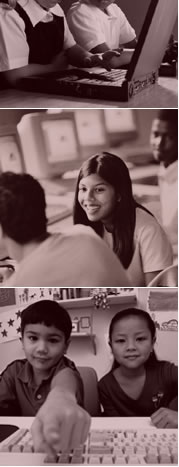Multicase
Reports > Sustainability and Transferability
Sustainability and Transferability of Instructional Reforms
Christine Korbak and Carlos Espinoza, SRI International
The schools in this group of case studies each made the commitment to improve
student learning by implementing innovative pedagogical practices using
technology. These innovations involved great investments in time and financial
resources. Therefore, it is encouraging that the teachers say they will
continue the innovations, and that teachers from all of the schools studied
held this view. It appears that a change has occurred in teaching practices,
not only at the school (meso) level, but also at the level of the individual
teacher (micro). This level of change is important for sustainability because
school-level changes may over time threaten the implementation of the innovations
school-wide. Individual teachers, on the other hand, can continue the innovations
to some extent within their own classrooms.
At the same time, there is reason for concern about the transferability
of these reforms to other schools. The issues of funding, changes in local
and state policies, changes in school leadership, teacher turnover, and
teacher burnout all limit the transferability of these innovations to other
schools.
Factors contributing to the Sustainability of the Instructional Reforms
There are a number of reasons why teachers at the case study schools are
likely to succeed in continuing the innovations: there was school-wide
involvement in implementing the innovations; the innovations are currently
supported by technology but are not necessarily technology-dependent;
the innovations played a role in establishing the culture of the school
and a shared vision; improving student learning is the focus and guides
the innovation; and the schools have learned approaches for integrating
the innovations within the constraints of other needs and demands.
Shared leadership.
In most of the schools, there were indeed one or more key leaders in implementing
the innovations, but these leaders did not act unilaterally; they involved
other teachers in developing and implementing the innovations. For example,
the Technology Specialist at Mantua Elementary said that teachers were
responsible for sustaining the innovation after the principal, a leader
in the school's innovation process, left the school.
When [the principal] left--was promoted in August--some people thought,
ahhh, what's going to happen when your school looses its leader. But
the school is full of teacher-leaders, and the teachers-leaders picked
up and continued on, and held the school up in transition which was
really, really exciting and refreshing … it proved to me, the whole
issue with teacher-leaders and the validity of what we're doing.
The fact that the teachers themselves sustained the innovation after
a key leader's departure proved to the Technology Specialist that the
innovation was not a temporary reform dependent on central leadership;
rather, the innovation had become an established part of teaching practice
at the school.
Innovations not dependent on technology.
Although the focus of these studies was the use of technology with innovative
pedagogy, not all of the changes in pedagogical practices are dependent
on the presence of technology. For example, the constructivist approaches
and high expectations for student achievement can be continued no matter
what technology is available to these teachers in the future. The Technology
Coordinator at Newsome Park Elementary School noted that from the start,
teachers did not use the term constructivism. And yet, their view of the
role of teacher reflected a constructivist view.
I think one of the challenges was just getting the process started
and getting an understanding throughout the school what constructivism
is. …Yet, when they describe their teaching style and how the perceive
themselves as a teacher, then they describe themselves and being a constructivist.
Therefore, the innovation is likely to be sustained in the form of constructivist
approaches by these teachers even if the availability of technology changes.
Establishment of school culture and shared vision.
In two of the schools studied, the innovations were planned with the opening
of those schools. Only teachers who were experienced with, or interested
in, the innovation were recruited to these new schools. In the other schools,
different approaches were used to ensure there was commitment to the innovation.
At one school, commitment to the innovation was gained gradually, as teachers
saw it having the intended impact on student learning. This gradual building
of commitment suggests that the teachers would be resistant to pressure
to abandon the innovations in favor of new trends. At the rest of the
schools, extensive professional development helped teachers to implement
and increase commitment to the innovations.
The existence of a shared vision and commitment to the instructional reforms
at the case-study schools suggests that that the transferring these innovations
to other schools would not be as simple as offering professional development
and infusing district support. Although these components were present
in the case study schools and their districts, shared vision and commitment
by school faculty and staff are generated from within the school and not
imposed from outside the school.
Focus on student learning.
The innovations at these schools required much time and effort for teachers
to understand and implement them. In interviews, teachers and administrators
often commented that the process of change had been difficult. But they
said their greatest motivator throughout the process was the desire to
improve student learning. This ultimate goal helped teachers to maintain
a focus on the innovation, despite the many trends and issues in education
that might have served to scatter their efforts. One of the teachers at
Newsome Park Elementary School summarized the process of change at that
school.
That's kind of the bottom line for all of us, student learning. So
it's not that we always want to get on the newest bandwagon, we want
to find out what's really helping children learn. … But we have, especially
those of us that have been here the five years, have really learned
to respect each others' ideas and needs and start to work together to
get things going for the kids. It's been a real journey in lots of ways
for all of us.
Comments such as these suggest that these teachers will be committed
to sustaining the innovations as long as they serve students' learning
needs.
Integration of the innovation within constraints.
Schools across the country have recently been striving to find ways to
effectively implement technology in the classroom. They have also been
facing increasing pressure to meet accountability measures, such as improving
scores on standardized tests. These schools faced the same pressures,
and have had some success in integrating innovations while dealing with
external pressures. For example, the principal at Mountain Middle School
described how teachers there match content standards with their assessments
of student learning, and with technology uses that support intended learning
outcomes.
I think standards-based education works backwards to that. It says,
here's what I want kids to know now, or I've built my assessment based
on what kids need to know to meet the standards, now how do I build
my lesson to get them there? It's just a different view of doing that,
and so I think technology, if the teacher has that end in mind, then
the technology can be just one of the tools to enhance them getting
there.
This process of integrating needs and goals within constraints is a process
that these teachers can sustain, despite changes that may occur in school
climate and access to resources.
Challenges in Sustaining and Transferring the Innovations
While individual teachers can sustain the innovations to some extent in
their own classrooms, schools face considerable challenges in sustaining
the reforms school-wide, and these reforms will not be easily transferred
to other schools. Some of these challenges include funding, changes in
local and state policies, changes in school leadership, teacher turnover,
and teacher burnout.
Funding challenges.
A major challenge in every case study has been to secure funding to purchase
hardware, software, and training. Keeping hardware and software up to
date requires careful budgetary planning, especially if the new technology
was provided as a one-time purchase. Along with the new upgrades are the
expenses to train teachers to use the new technology.
While funding plays a major, if not essential role in continuing school-wide
reform and maintaining technology, funding solely cannot leverage transferability
of these instructional reforms. Teachers and administrators need to see
that the use of technology in instruction is leading to student gains.
As the principal at one school stated:
Teachers don't receive additional money here for using technology.
The incentive is that they see progress from their students. They are
finding that classrooms are more dynamic. And I think that they have
an intrinsic motivation to grow professionally.
State and local policy changes.
Student achievement was emphasized over technology at all of the case
study schools. In no instance did anyone interviewed lose sight of the
fact that the technology was a tool to facilitate instruction. This message
may very well come from the districts of some of the schools. In the example
below, a district policy that defunded technology specialists generated
an alternative position to more closely focus on student achievement.
Part of my position is still funded by the district, and that's why
I'm called a student achievement specialist. They weren't funding technology
specialists because they want to focus on the fact that whatever you're
doing is relating to student achievement. So, I'm a student achievement
specialist.
Often within the districts of the case study schools, policy changes
reflected support for technology innovations. District office technology
coordinators were very aware of the technologically savvy case study schools
and their exemplary status and potential to model effective innovative
practices.
Teacher attrition and burnout.
Teacher attrition is a challenge because presumably the innovation mastered
by the teacher would also leave the school when the teacher left. Teacher
burnout, staff exhaustion and cynicism often affect how, and even whether,
these reforms are implemented. One aspect of the schools in these case
studies that kept burnout in check was the supports in place by the school
and district. The technical coordinator often provided instructional support
for teachers and in some cases team-taught classes that used technology
that was new to the classroom teachers.
Aside from professional development, districts also can facilitate the
use of technology in the schools by providing support in fixing, upgrading,
and connecting hardware as well as cataloging and evaluating software.
We have great direction from the District office, as far as which products
we will invest in. I'm not out here spending a lot of time going through
catalogs and saying that this looks like a great CD ROM we can use,
or this teacher and that teacher. Which I think is an advantage, because
then we are not out here sort of on our own experimenting with something
we think that might work. The most important is supporting the hardware,
and software issues. When I've got a keyboard that is dead, that computer
is out of commission for two days now, so we are having to shift around,
send kids up to the media center. Because suddenly we don't have enough
spots for kids who are supposed to be on computer.
Reflections Across the Case Studies
Certainly, these schools have a good probability of continuing the instructional
reforms that they have adopted. The necessary systemic factors are present
in the state and district environment of which each school is a part.
However, the case study schools had also produced a shared vision among
faculty and staff as well as a commitment to the innovations. Perhaps
because systemic factors appear necessary, but not sufficient to sustain
the instructional reforms, the transferability of the innovations is far
less certain than their sustainability. Further analysis of the data should
reveal whether this hypothesis holds true.
|



